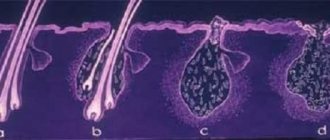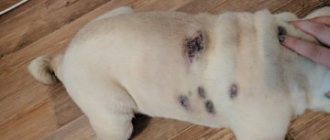The veterinarian talks about the disease
- Fact 1:
Pruritic scabies, as they also say when they mean sarcoptic mange, is a highly contagious skin pathology. - Fact 2:
Ear mites, ear scabies - this is what the common people call this infestation of a pet's ears by mites. - Fact 3:
Ear scabies spreads very quickly in the ear canal, spreading to the middle ear and then the inner ear - Fact 4:
Demodex is not contagious, although many believe otherwise. It is not transmitted to humans or other animals in the house
Canine scabies has several forms and causes. The definition of “scabies” includes several skin pathologies characterized by subcutaneous mite damage to the dog’s ears, upper or deep layers of the epidermis.
Sarcoptic mange
Pruritic scabies, as they also say when they mean sarcoptic mange, is a highly contagious skin pathology. It does not depend on the time of year and is unpleasant because female ticks in the epidermis literally gnaw passages into the deep layers of the skin, move along them and leave egg clutches. To gnaw out “tunnels,” the tick selects areas with short hair on the dog’s body, namely the head and joints. On the head, sarcoptic mange affects the pet's ears, the area above the eyebrows, and the back of the nose.
Sarcoptes - sarcoptes. They are very small in size and therefore cannot always be seen. These whitish parasites have a flat body and have hard spines on their legs, with which they easily cling to the fur and skin of animals and humans.
The first manifestations of the disease are barely noticeable dots, which become ulcers within 1.5-2 weeks. The sores are very itchy and do not give the animal rest.
Obvious symptoms of sarcoptic mange:
- Constant itching of the affected areas.
- Restless behavior of a ward who cannot find a place for himself.
- Scabs and crusts in places where scratches were made.
- There is bloody discharge under the scabs at the scratch site.
- Abnormally large amounts of dandruff (especially in the ear areas).
- "Ear-foot" reflex. When touching the shell of the ear, the pet instinctively tries to itch.
Diagnosis involves laboratory testing of scrapings from the affected areas of the epidermis. Samples are taken from the deep layers of the skin by making an incision until the blood is drawn to collect biomaterial.
Diagnostics
Sarcoptic mange is diagnosed based on clinical presentation, microscopic analysis of skin scrapings, and trial treatment.
It is not always possible to make an accurate diagnosis based on external signs, since the symptoms of scabies resemble other skin pathologies:
- atopic, flea, contact dermatitis;
- food allergies;
- demodicosis;
- superficial pyoderma;
- cheyleliosis;
- dermatophytosis;
- notoedrosis.
To clarify the diagnosis, a microscopic analysis is prescribed. Numerous superficial scrapings are taken from the dog from typical areas of scabies. The diagnosis is confirmed when mites, larvae, eggs, and excrement are found under a microscope. However, traces of parasites can be detected in only half of the dogs; according to other sources, in 20%.
An adult scabies itch under a microscope.
If the tests show a negative result, and the clinical picture of sarcoptic mange is obvious, then a trial treatment is prescribed. The diagnosis is confirmed when anti-tick therapy helps alleviate the symptoms and the dog is on the mend.
Before visiting the veterinarian and taking scrapings, the pet is not washed, treated with anything, or given any medications.
Otodectosis
Ear mites, ear scabies - this is what the common people call this infestation of a pet's ears by mites. Most often, it affects dog breeds with drooping hearing organs. Their structure and shape are the most optimal in terms of conditions for the reproduction and life of the parasite. The pest is located in the external auditory canal and the auricle. With prolonged direct contact of a sick animal with a healthy one, the tick is transmitted to a neighboring organism. Cases have been recorded in which a person became infected with otodecosis from their sick pet.
Otodectes cynotis , which lives on the surface of the skin. The tick parasitizes only one area of the body – the ears of animals.
The ectoparasite attaches itself to the upper layer of the skin and begins to actively function, feeding on dead epidermal cells, blood, and earwax of the animal. Having reached maturity, the causative agent of scabies penetrates deeper into the skin, causing unbearable itching.
Signs of otodecosis:
- The animal shakes its head all the time and tilts it towards the diseased ear organ.
- Starts to rub against hard objects with force. Sometimes this causes cuts, scratches and other microtraumas, which later begin to fester.
- A brown “gluten” forms in the ear—excretion products as a result of the tick’s activity.
Ear scabies spreads very quickly in the ear canal, spreading to the middle ear and then the inner ear. Through it, the disease can reach the meninges. Without timely treatment, otodecosis leads to complete hearing loss. Despite the pronounced symptoms, laboratory tests are often required to make a correct diagnosis.
Causes of itching in dogs
Various ectoparasites.
Insects that parasitize animals include not only the well-known fleas (fleas on dogs), but also other arthropods - lice, ticks (ticks on dogs), lice eaters.
Owners who have treated their dog for fleas cannot be completely sure that they have managed to get rid of them. Since flea eggs and larvae can remain on the dog's bedding, in furniture upholstery and carpets. Therefore, you need to once again carefully examine the dog’s fur to identify eggs and adult fleas.
If the dog continues to itch, but does not have fleas, you need to examine the skin for the presence of other insects:
Ticks : dogs are most often parasitized by three types of ticks: Ixodidae - are the largest ticks, which in a hungry state reach 2-3 mm in length, and when fed with blood - up to 1-1.5 cm. Scabies (internal, ear). Subcutaneous (demodectic).
After a tick attack, dog owners usually note the following symptoms in their pets: lethargy, low activity, the dog lies down more, and begins to itch. There is a change in the color of urine (the urine becomes dark, sometimes acquires a brown, brown or red tint). The visible mucous membranes and sclera of the eyes have an icteric tint. Body temperature rises to 40°C and above. Shortness of breath appears, the dog has difficulty breathing.
An attack by ixodid ticks on a dog can cause life-threatening diseases such as piroplasmosis (pyroplasmosis (babesiosis) of dogs), Lyme disease, ehrlichiosis, and hemobartonellosis. The secretion of the salivary glands of mites leads to severe itching and scratching in the dog's head, ears and neck. Externally, the dog itches all the time and scratches its skin.
Scabies mite (itchy) - parasitizes a dog's ears, where it feeds on the secretions of the sebaceous glands and wax. To get to the lymph, it gnaws passages in the skin, as a result, the affected area of the dog begins to itch very much, the dog begins to intensively scratch these areas with its front and pelvic limbs, shake its ears, and rub its auricle against surrounding objects.
With severe infestation, the dog constantly moves and practically does not sleep. Upon examination, abrasions, scratches, wounds, pustules and areas of baldness are visible on the head and ears. Otodectosis in dogs is often accompanied by weakening of hearing, up to its complete loss. From the affected ear there may be discharge of various types, most often serous, which is later replaced by purulent discharge (ear diseases in dogs).
The subcutaneous mite is capable of parasitizing on the surface of the epidermis for a long time, feeding on horny scales. When immunity decreases, the mite penetrates deep into the skin, causing severe itching. Infection with subcutaneous mites (demodex) causes a dog to lose appetite, the dog becomes depressed, itching appears, redness of certain areas of the skin, the formation of scabs, nodules on the skin and the inner surface of the ears, scratching and red spots appear on the nose, around the mouth and eyes.
For more information about demodicosis in dogs, see our article - treatment and prevention of demodicosis in dogs.
Vlaseaters.
Owners can, after consultation with a veterinarian, prevent a dog from becoming infected with ticks, lice eaters and fleas by treating the dog with one of the medications in the form of a spray (Bars, Bolfo, Frontline, Defendog), drops (Serco, Bio Spot on drops, Advantis, Ralph Club, Prak- teak, Stronghold), or wearing a protective collar against ticks (Kiltiks, Foresto).
Allergic reaction to various irritants
If an examination for the presence of ectoparasites in a dog gives a negative result, and the dog continues to itch constantly, then you should suspect an allergy that is widespread in our time, which is caused by the following factors:
- Household chemicals and hygiene products.
- Bites by ectoparasites.
- Food allergies.
- Reaction to vaccination against infectious diseases and medications used in treatment.
Infection of a dog with fleas leads to allergies; secretions of the salivary glands of fleas when they enter the bloodstream lead to a reaction on the part of the animal to the foreign protein introduced into its body. Especially when the dog has already suffered from a flea attack.
Food allergies in dogs are caused by proteins or non-protein components of food (food allergy in animals). To distinguish intolerance to certain foods from a true allergy, dog owners should contact the clinic’s veterinary specialists, who will carry out the necessary differential diagnostics and determine the cause of the allergy.
Allergies in dogs are most often caused by foods such as milk, horse meat and beef. The second group of allergenic foods for dogs are soy, chicken, and lamb. Many premium foods purchased by owners contain the products listed above.
A dog's allergy is accompanied by such severe itching that the dog itches by biting these places. At the site of severe licking, hair falls out, leading to complete baldness, discoloration of the coat, pyoderma, coarsening and hyperpigmentation of the epidermis.
Young dogs under 5 years of age are most susceptible to the disease. Of the breeds that suffer most from food allergies: pug, boxer, sharpei, chow chow, cocker spaniel, beagle, German shepherd, labrador, etc.
Allergies can be triggered by improper use of medications - eye and ear drops, sulfur ointment and other irritating ointments, vaccines, etc. The manifestations are the same as with other types of allergies. If your dog itches after taking flea drops, then it is highly likely that he is allergic to this product.
Skin diseases
The dog itches a lot and with various skin diseases. The most common are lichen (ringworm in dogs), wet or dry eczema, and dermatoses.
Dermatosis, one of the symptoms of which is itching, can be caused by contact with the collar. This form of the disease is often observed in puppies, since their delicate skin is very sensitive to constant exposure to insecticides. The puppy is itching, trying to remove the collar.
To treat allergic reactions, veterinarians prescribe cortisone and other antihistamines that help relieve skin manifestations and itching (Benadryl, Tavist, Amitriptyline, Atarax).
Dermatophytosis in dogs
Dermatophytosis is often seen in puppies, young animals, and dogs with compromised immune systems. Mycoses cause not only itching, but also hair loss, nodular lesions of the skin, peeling and yellowing of the nails, peeling and cracking of the pads on the paws.
Veterinary specialists for dermatophytosis in sick dogs prescribe body treatment with antifungal agents - shampoos (Nizoral, Dermazol) or the drug for dogs Imaverol. For systemic treatment, the following drugs are used - Orungal (Itraconazole), Lamisil (Terbinafine), Nizoral, Oronazole (Ketoconazole).
In healthy dogs, dandruff is absent or invisible. Dandruff flakes can form under the influence of various factors that cause dry or oily seborrhea. When a Spitz itches or the itching bothers representatives of other “sofa” breeds, the cause is dry seborrhea. These animals are bathed frequently, which leads to dysfunction of the sebaceous glands and dry skin. Also, a lack of fat leads to the formation of dry dandruff. If the cause is not a fungal infection or systemic diseases, then the doctor prescribes antiseborrheic shampoos.
Inflammatory dermatitis often occurs in dogs with large folds of skin. If a pug itches, or a chow-chow, bulldog, or mastiff scratches its muzzle with its paws, then it is worth checking the folds, where you can detect redness of the skin and increased humidity, swelling and destruction of the epidermis.
Treatment of dermatoses begins with treatment with antibacterial, disinfectant detergents, and then treated with drying preparations. If the process is advanced, the doctor prescribes antibiotics.
Hyperfunction of the sebaceous glands
Some dogs have a pathology called “greasy tail.” This pathology is more common in cats, but can also occur in dogs. Hyperfunction of the sebaceous glands, located like a rosary on the upper surface of the tail and around its base, leads to sticking of the hair, the formation of black spots on the skin, and the appearance of oily seborrhea. Itching causes the dog to chew its tail, “ride” on its butt, and causes severe discomfort. A dog's licking of affected areas can cause alopecia or serious tail injuries.
Treatment consists of treating the wool with special shampoos to regulate the function of the sebaceous glands. Until the cause of the hyperfunction is determined, this is the only method to help the dog.
Stress
In dogs, the nervous system reacts to prolonged exposure to stress factors with various manifestations, including skin ones. Short-term factors - a visit to the doctor, injections, a sharp shout, an unpleasant strong odor - cause a reaction that disappears when the irritating factor disappears. Prolonged stress can lead to various external manifestations, including increased licking and biting of certain parts of the body due to allergies or seborrhea.
Treatment consists of eliminating the stress factor, providing positive emotions, and distraction. Occupational therapy brings a good therapeutic effect. For chronic stress, your doctor may prescribe sedatives.
Demodicosis
Another very common pruritic skin lesion in the canine tribe. The causative agent is the demodex mite. This parasite is present in limited quantities in any dog as part of the normal microflora. Under favorable conditions, and this is either a weakened immune system or a genetic predisposition to dysfunction of T-cell immunity, an abnormal, rapid increase in the Demodex population begins.
Demodex - Demodex are mites that live on the body of an adult dog and do not cause any problems as long as the animal's immune system is in good order. When the body is impaired or weakened, the parasite begins to multiply uncontrollably and affects large areas of the skin.
The parasite operates in hair follicles and on the skin surface. Demodex is not contagious, although many believe otherwise. It is not transmitted either to humans or to other animals in the house. The disease begins suddenly, without any apparent reason. Demodex mites mainly affect the dog's muzzle and organs of vision.
Veterinarians know two types of demodex:
- Localized . 4-6 lesions on the pet’s entire body. Puppies 3-6 months old are susceptible to the disease.
- Generalized . The localization of the spots is more extensive, more than 5. The age for the lesion is from 3 months to one and a half years.
Routes of infection
A dog becomes infected with ticks mainly through contact. An indirect route of transmission of scabies through toys, bedding and other objects is also possible if there is a high concentration of parasites on the animal’s body. A pet can become infected from these ticks; ticks are capable of attacking wild and domestic carnivores (cats, arctic foxes, foxes, ferrets).
In dogs, the disease appears 14 days after infection. The tick mainly affects the neck, head, and limbs of the animal. The most susceptible to infection by parasites are young and weak individuals, in whom the symptoms of the disease develop rapidly. Smooth-haired dogs are more susceptible to tick attacks.
Notoedrosis or Cheyletiosis
Cheyletial scabies infection is a very contagious disease, the treatment of which must be carried out without delay, since the mite can infect not only the dog, but also the owner in particular. The parasite lives in the upper part of the epithelium and lives by absorbing tissue fluid and dead cells. Most often localized in the cervical, dorsal and ear regions.
Cheyletiella - cheyletiella . A tick that is extremely contagious. It usually lives in the area of the animal's neck and ears. It can bite a person like a flea, but does not live on it for long.
Identifies the following symptoms:
- Characteristic loss of wool hairs in clumps.
- The animal scratches uncontrollably at infected areas of the body, which may be inflamed.
- The formation of ulcers and rashes, as well as dense scales and crusts.
The most unpleasant type of scabies disease is notoedrosis. The tick that causes itching is localized deep under the skin epithelium and moves freely, so the disease is considered very contagious and can spread to the dog’s owner.
Characteristic signs are observed
- on the frontal lobe
- eyebrows,
- in the head and nose area,
- and look like small bubbles.
The main symptoms in young dogs are hair loss. It is not recommended to treat the disease at home without first examining the animal at a veterinary clinic.
Breeds prone to mange
Any animal can get sick, but most likely this will happen to those tails that have reduced immunity.
But there is also a breed predisposition, for example, for demodicosis:
- boxers;
- pugs;
- French Bulldog;
- Rottweiler;
- German Shepherd;
- Staffordshire Terrier;
- dachshunds;
- Dobermans;
- English and American cocker spaniel (the greatest tendency to damage the limbs is demodicosis of the paws).
Breeds with long, floppy ears are most susceptible to otodectosis.
What will happen if left untreated?
Parasites found in a dog's ears pose a great danger. Unqualified assistance or its complete absence can lead to serious consequences - deafness, meningitis. These pathologies, in the absence of veterinarian help, in most cases lead to death.
The main danger of ear mites is that even after a course of therapy, relapse and deterioration of the pet’s condition are possible. This is due to the fact that not all medications are effective against mite eggs. Thus, after treatment, larvae appear from them, which begin to feed on the blood of the pet, while the dog experiences serious discomfort - constant itching, shaking its head, itching, any sudden movement causes pain.
Ticks can provoke the development of an infection that is dangerous to the dog’s health and life. According to statistics from veterinary practice, a third of all infectious diseases end in the death of a pet.
FAQ
Is scabies transmitted to humans?
The answer is YES, but partially! There are nuances depending on the type of tick.
Thus, if your dog has sarcoptic mange or cheyletiosis, you run the risk of contracting pseudoscabies. It does not require treatment, everything will go away as soon as the source disappears, in other words, when you cure the dog.
Demodectic mange and ear mites have strict species specificity and are completely safe for humans.
But if your pet has notoedrosis, then you will soon become infected with true scabies. Although this type of tick is less likely to infect dogs than cats, they can carry it, so be careful.
How to distinguish scabies from other diseases?
Itching is a sign of many diseases, both life-threatening and harmless to your pet. The true cause of itching and other clinical signs can only be determined in a clinic by taking a scraping or smear. This is the only way to differentiate scabies from other diseases and determine the specific type of parasite.
Why is scabies dangerous?
First of all, the constant debilitating itching causes excruciating discomfort for the dog. Not only from the physical side - the dog scratches his skin until it bleeds, and this is a direct path for infection, which greatly complicates the situation and leads to other dermatitis. Constant itching can develop mental disorders in a pet, it becomes irritable, fearful, and aggressive.
Treatment, medical procedures, therapy
The following treatment regimens are most effective:
- Lubricating the areas affected by ticks with a solution of hyposulfite (sodium thiosulfate) at a concentration of 60%. A protective collar is placed on the dog's head to prevent it from licking the medicine. After the lubricated parts have dried, they are wiped with a 10% solution of hydrochloric acid. The procedure is repeated after 3 days. Two procedures are enough to completely destroy the tick.
- In the absence of the above-described drugs, you can inject the dog subcutaneously with the drug Ivomek (or any drug based on ivermectin - Tsevamek, Novomek, Baymek, etc.) at the rate of 300 mcg per kilogram of the animal’s weight.
- Bravecto tablets can be used against this type of tick .
- You can buy Bars drops , the active ingredient of which is diazinon. To kill ticks, you need to instill 3-6 drops of the product into each ear (depending on the weight of the animal). The instillation procedure is repeated after a week.
- Surolan drops have a wide spectrum of action. They are effective against ear mites, and also relieve allergic manifestations and eliminate inflammation. The instillation regimen is as follows: 5 drops 1 time per day. Treat each ear. Treatment lasts 14 days. The drug is acceptable for use in pregnant and lactating animals.
- Stronghold drops on the withers contain the active ingredient – selamectin of varying concentrations (6 and 12%). When treating ear mites, the drug is applied to the area between the shoulder blades once, and after a month the treatment is repeated. Cannot be used on puppies up to one and a half months old.
- The easiest way to treat scabies is the new Amidel gel Neo . This is one of the most effective domestically developed means used in the initial stages of infection. In advanced conditions, the drug is combined with ivermectin injections.
Amidel gel is a glycerin-based preparation containing:
- Cyflutrirn is a contact poison, safe for dogs, working in the upper layers of the skin.
- Lidocaine is an anesthetic that reduces itching and relieves pain.
- Chloramphenicol is an antibacterial substance that prevents the development of inflammation on the skin. Unlike antibiotics taken orally, chloramphenicol does not affect the intestinal microflora, therefore, dysbiosis does not develop from it.
- Dimethyl sulfoxide, polyethylene glycol-400 are auxiliary substances that have a softening effect on the formed crusts, which ensures the absorption of the medicine into the epidermis.
For better access to the affected areas of the skin, the hair around them is carefully trimmed. After destroying the scabies mite, wound healing ointments are used on the inflamed areas:
- Methyluracil,
- Levomekol,
- Solcoseryl.
To relieve pain, the dog is prescribed painkillers.
Spitz puppy itching behind the ear
Hello! I have a Pomeranian puppy. We are 1.5 months old. Today I noticed that the puppy sometimes scratches behind his ear and seems to touch it with his paw. At the same time, he does not shake his head. Gives touch to ears. I carefully cleaned my ears with a cotton swab. There was a little dirt. What could this mean? Why is it itchy? Thank you in advance.
Answer 3
The ears are considered a sensitive organ. The skin of the ears is delicate. Rough actions will cause wounds. The protruding location of the hearing organs causes daily scratches, while deep concealment complicates inspection. Thick fur is reliable protection.
Periodic cleansing of this part of the body is necessary. Dirt located inside can cause illness. Washing with water and soap is prohibited. Liquid getting into the ear cavity causes discomfort. Ears are protected during water procedures.
Hearing locators need to be cleaned once a month. It is not advisable to increase the frequency. Sterile frequency is harmful. The minimum amount of sulfur ensures the maintenance of the necessary environment of the ear canals. The absence of secretion will cause a negative reaction from the body and discomfort.
The procedure is performed using cotton swabs. The cotton wool is moistened with olive oil. Use a stick to wipe the inside of the shells, removing excess sulfur. Oil softens sulfur. The substance can be removed mechanically. Disinfection is carried out in the same way. The stick is impregnated with boric alcohol. The actions will be repeated. The device cleans folds and pockets.
Cleaning actions must be performed carefully. Spitz ears are sensitive. Deep immersion of cotton swabs is prohibited. The presence of sulfur plugs is eliminated by medical intervention. Urgent medical attention is necessary if, instead of sulfur, another substance is released that has a bitter odor; the color of the painful discharge is brown, reddish, or yellow. Such discharge is accompanied by itching.
Spitz fur is thick. Trimming the hair around the ears is prohibited. The hair protects the ears. Long hair sticking out of the ears is cut off. Scissors with blunt tips are required. This configuration ensures the safety of the auditory conchas. Sharp objects can cut thin skin.
Causes of ear scratching
Insects can cause itching. Parasites attack puppies and adult dogs. Irritation is caused by insect bites and movements. Waste products lead to discomfort. There are special formulations for parasites. Animal skin is processed.
Unpleasant sensations are caused by excess sulfur. Excessive cleanliness is dangerous. But neglecting ear cleaning is prohibited. Monthly care required. The unpleasant procedure can be performed by veterinarians.
Ear hairs also cause discomfort. Long hair tickles my ears. Hair is cut or pulled out. After the procedure, the surface is treated with boric alcohol. If there is no alcohol, brilliant green will do.
Scratching is also caused by damage to the skin: scratch, abrasion, eczema. Eczema manifests itself as redness of the upper layers of the skin. After a while, swelling forms. The surface bubbles and ulcers appear. The affected area becomes wet or becomes covered with dry scales. The skin must be treated with alcohol or hydrogen peroxide. The inflamed areas are covered with green. The veterinarian prescribes medications to the patient. Self-prescribing medications is dangerous.
Disinfection and medications are required if the eczema is external. Internal damage to the skin indicates serious problems. Carrying out disinfection measures after a couple of days leads to the disappearance of skin damage if the pet is healthy. Deterioration of the condition will indicate suspicion of scabies and other serious diseases. You need to protect your ears from dog paws. Further treatment is carried out by a veterinarian.
Precautions and whether a person can become infected
Scabies mites can only grow on dogs. When they come into contact with human skin, they can cause pseudosarcoptosis, an allergic reaction to the presence of arthropods. They cannot feed, reproduce or gnaw holes; they die of hunger, but they are capable of causing discomfort.
Therefore, treating dogs against scabies mites must be done with gloves. An infected dog must be isolated from healthy pets. The latter must be subjected to prophylactic treatment with external agents that are used to treat a sick dog. The apartment is treated with insecticides twice, with an interval of 14 days.
Human scabies can only be contracted from monkeys. They are parasitized by the same type of scabies mites as humans. But precautions should still be taken when handling and handling sick dogs.
Veterinarian recommendations
Dogs infested with ticks should be clipped as soon as possible. Long hair does not contribute to treatment - it also obstructs air flow and causes irritation.
Hair trimming is the first step in preparing the skin for further treatment. The skin must be thoroughly cleansed using special products.
It is recommended to use shampoos, antipruritic drugs, and also give the dog anti-scabies after the end of therapy to prevent relapse of the disease.
It is also worth disinfecting brushes, combs, toiletries and other dog accessories, as mites can remain on them for several weeks.
Sources
- https://sobaki-pesiki.ru/chesotka-u-sobak-simptomy-lechenie.html
- https://usatiki.ru/chesotka-u-sobak-simptomy-i-lechenie/
- https://dog-care.ru/zdorove/bolezni/chesotka-lechenie.html
- https://kleshun.ru/chesotochnyj-klesh/
- https://KlopVred.ru/kleshhi/chesotochnye-kleshhi-u-sobaki/
- https://apest.ru/kleshhi/kleshhi-u-zhivotnyh/chesotochnyj-kleshch-u-sobak/
- https://deziplan.ru/kleshhi/o-kleshhax/chesotochnyj-kleshh-u-sobak.html
- https://VrediteliSOS.ru/nasekomye/kleshhi/podkozhnyj-kleshch-u-sobak.html
- https://vokrugsobak.ru/demodekoz-u-sobak-foto-lechenie-simptomy-preparaty/
- https://mirsobaki.ru/chesotka-u-sobak/
- https://www.1001dog.com/polezno-znat/vneshnie-kozhnye-parazity-u-sobak-i-ix-simptomy-na-foto.html
[collapse]
Prevention
- It is necessary to systematically examine the animal, its skin and ears.
- Watch your pet. If his behavior has changed, the dog is itching all the time, is restless and his hair has begun to fall out - this is a reason to consult a veterinarian for advice.
- If possible, avoid places with large concentrations of animals, as well as forests and forest plantations.
- Do not allow sick pets to interact with healthy ones. At the veterinary clinic, keep your dog and cat away from other animals.
- Regularly treat your pets with medications against ticks, fleas and worms; if necessary, bathe cats and dogs with special shampoos.
- Systematically give your pet vitamins and minerals and strengthen the immune system in every possible way. This will minimize the likelihood of developing the disease and strengthen the body's protective functions.
Development of the disease
At the first stage, redness appears on the skin and the pet begins to itch. Unfortunately, at this stage, owners do not pay attention to the symptoms and do not even suspect the presence of the disease. After all, it is quite normal for a dog to scratch itself and there is no reason to immediately examine the skin and suspect a problem.
Next, small red dots called pustules begin to appear on the skin. They are filled with liquid and when the animal itches they burst. In places of pathological foci, hair begins to fall out, and the skin becomes very rough. Rejected skin particles also appear, they are very similar to dandruff.
The skin condition worsens, loses elasticity and becomes rougher. Moreover, when such areas are scratched, the skin cracks and bloody cracks appear. The condition of the coat also deteriorates significantly; in the affected areas it falls out intensively, and in other areas it becomes dull. The dog refuses to eat and begins to lose a lot of weight.
Quite often other infectious diseases develop, which significantly complicates the general condition. It is worth saying that only a specialist can diagnose the disease after examination. Everyone experiences the disease differently, and symptoms may vary.











